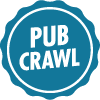
Guest Post: Choosing the Right Pen
[box type="note"]Eugene here. Today I have a guest post from author Corinne Duyvis, who's here to share her thoughts on choosing the right pen to sign your books with![/box]
When I saw the interior design for my upcoming debut novel, I was thrilled. The title page is all black, starry skies, with stylish white text—it's gorgeous.
It meant I’d have a lot more trouble finding a proper signing pen, though, and I thought I’d share my findings here for anyone in the same boat.
My demands were this:
The pen should show up well on dark paper.
If possible, it should work on smooth/glossy paper, as well, for people signing bookmarks or picture books.
Ideally, the pen should be archival. (Archival means a pen will last basically forever: fadeproof, UV-resistant, water-resistant, acid-free, et cetera.)
If that’s not doable, just acid-free is fine. Most of us aren’t planning to dunk our signed books in a bathtub, anyway. (If a pen is not acid-free, it’ll damage the paper over time. Truthfully, I don’t know if that means “within a few years” or “within a few decades,” or the extent of that damage, but I wanted to be on the safe side.)
It should be fast-drying/smudge-proof. Books are usually closed quickly after signing, and I'm a lefty, to boot. Authors signing books for younger kids might also have to deal with tiny fingers immediately “testing” the signature.
I did a lot of research online and came up with a few options—mostly gel pens. JetPens.com was kind enough to provide me with several samples in return for writing this comparison post. (While you can purchase the pens from wherever you like, I linked to JetPens where possible, and have only good things to say about their website. Check 'em out.)
Most of the pens I used were silver:
Sharpie Permanent Marker (not acid-free/archival; I included it for comparison purposes since it's so widely used)
Faber-Castell Pitt Artist Pen (archival)
Zebra Sarasa Retractable (archival)
Uni-Ball Signo Noble (acid-free)
Uni-Ball Signo Broad (acid-free)
Pentel Slicci (acid-free)
And I threw in a white pen from my own collection:
Pentel Hybrid Gel Grip (acid-free)
I also tried a number of blue pens, to provide options for those wanting a little more color:
Faber-Castell Pitt Artist Pen (archival)
Uni-Ball Signo Angelic (acid-free)
Uni-Ball Signo Noble (acid-free)
Pentel Slicci (acid-free)
APPEARANCE
The first and most obvious test I put the pens through was—how clearly do they show up?
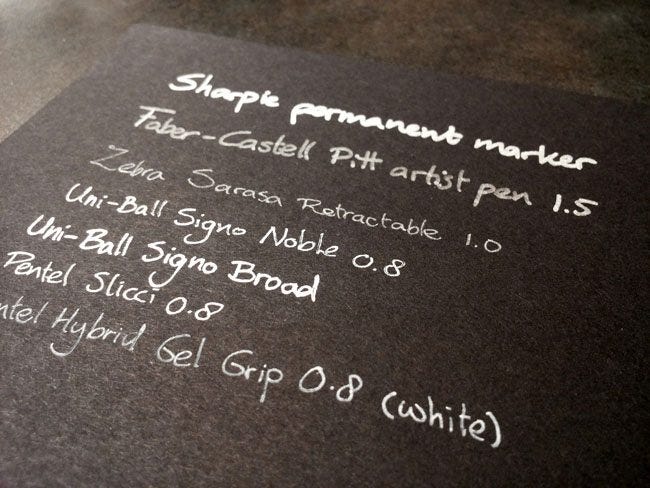
In the silver-white department, the clear winners are the Sharpie and the Signo Broad. The unfortunate loser is the Zebra Sarasa, which has the thinnest, scratchiest line of them all. The FC Pitt acted unusually: it shows up beautifully when you first write, but within a second, the ink seems to get soaked up by the paper and becomes darker as a result.
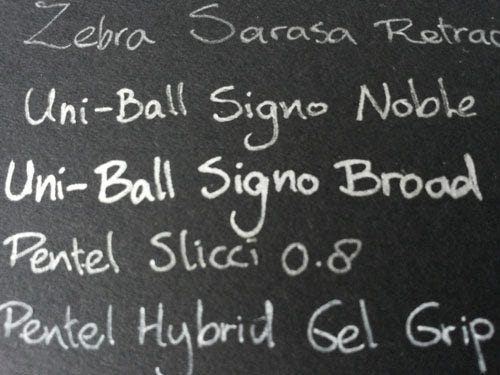
This close-up of the gel pen options shows that the Hybrid Gel Grip and the Signo Noble are a little unequal with their ink distribution, and also shows the difference between the Broad and the Slicci and Noble better--in the first photo they appear to be equally bright, which isn't the case in actuality.
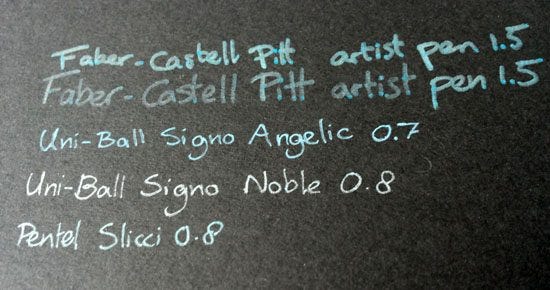
Although I'm not thrilled about the ink distribution of any of the gel pens--and the Signo Noble in particular looks kind of scratchy--the Signo Angelic unquestionably shows up best. It's also the least metallic of the three.
The blue FC Pitt got soaked into grayish translucency almost instantly, with bright spots of blue remaining where the ink was applied thicker. This puzzled me--I'd tried the Pitt before, and remember it showing up better--so I grabbed a different Pitt pen I had lying around and tested it. Lo and behold: it looks much better. I might have simply gotten a dud.
(After this, I went back to the silver FC Pitt. Here, too, a different pen garnered much better results.)
I also tested all the pens on white paper, for those curious how they show up on a different background. (Yes, I included the white pen. I... don't know what I expected.)
SMUDGING
This test was straightforward: scribble, then smudge. I held off two, four, and six seconds on different smudges.
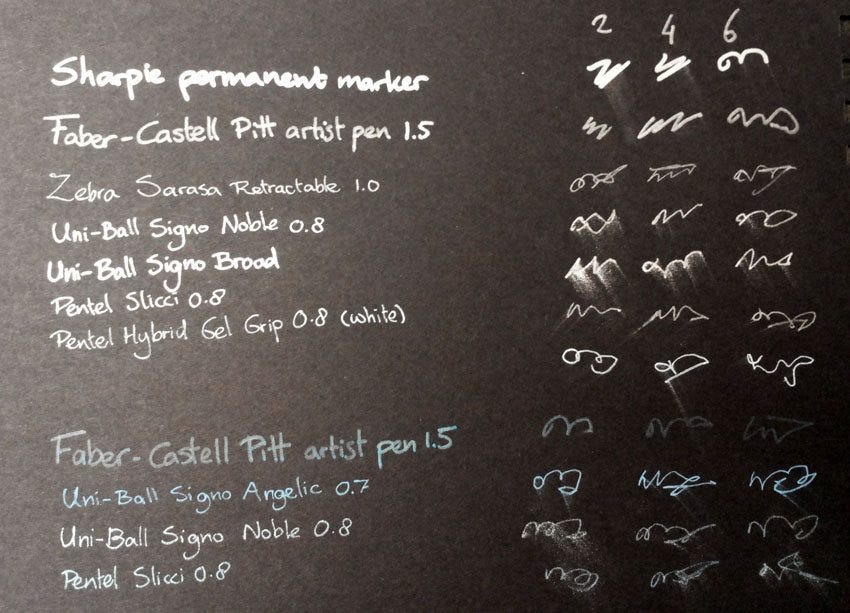
In the silver/white department, the FC Pitt and Zebra Sarasa came out ahead, with the Sharpie and Hybrid Gel Grip close behind--as long as you wait a few seconds. While the Signo Broad won the previous test, in this one, it rates disastrously.
With regards to the blues, the FC Pitt again won. The Signo Noble did all right after several seconds, as well.
Most of us won't need to worry about this level of smudging--the worst problem is whether the ink is visible on the opposite page after you close the book. To test this, I folded a black sheet of paper, wrote on one side, waited a few seconds, then folded it and pressed down. I repeated this with every pen. Here's the results:
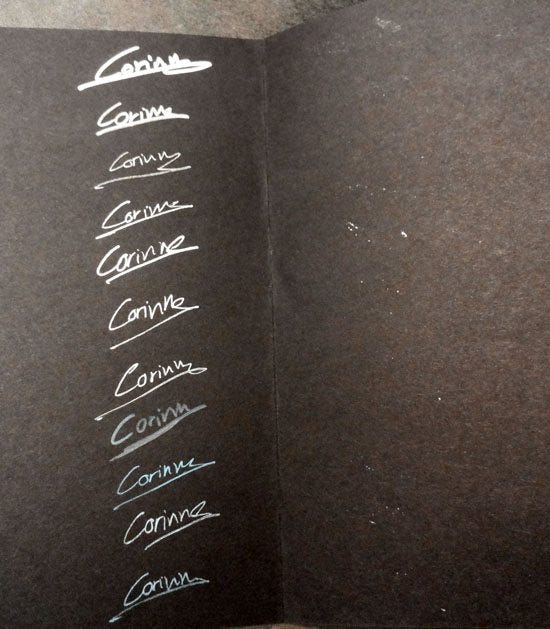
I have to be honest: I'd expected much worse. The Sharpie showed a little bit, as did as flecks of the Signo Broad. I tested them out a couple more times, and results varied. Definitely don't close the book too soon on the Broad, or you'll get a near-mirror image on the opposite page. The Sharpie held up better in repeat tests and didn't show at all.
Most of the other gel pens showed slightly as well, but nothing disastrous. The FC Pitt pens held up particularly well.
I used my signature for the above test since that's a quick scribble, which created an extra opportunity to test out the ease of writing. The non-gel pens wrote wonderfully, while the gel pens reacted pretty much as gel pens do--the faster you write, the more you see that telltale line through the middle of your strokes. The Signo Broad skipped in the middle, which you can see better in this close-up.
SMOOTH PAPER
Next, I tried the pens out on smoother paper to see how they held up in those circumstances. I scribbled a bit on some bookmarks I had, waited a few seconds, ran my finger over, and... well...
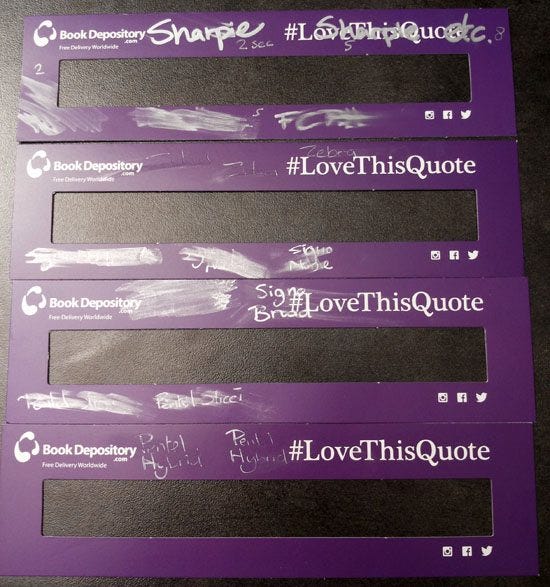
The results were not great, to say the least. Almost all of the ink was smudged into illegibility. (I'd show you the results of the blue pens, but they're equally useless.) The only one that held up in any way was the Sharpie--although even then you have to wait several seconds to let it dry.
I decided to keep testing the Sharpie and tried it on the glossiest bookmark I had. It smudged a little, but was as permanent as its name implies after a few seconds. I also tried it out on a few different backgrounds to see how well it shows up, and the results are pretty much what you'd expect—great on dark and medium colors, not-so-great on light colors.
BONUS ROUNDS
I did a quick bleeding test on the thinnest paper I had in the house—a groceries receipt. The pens passed with flying colors. The only pen that showed on the other side was the Sharpie, and even that didn't bleed through onto the next sheet of paper.
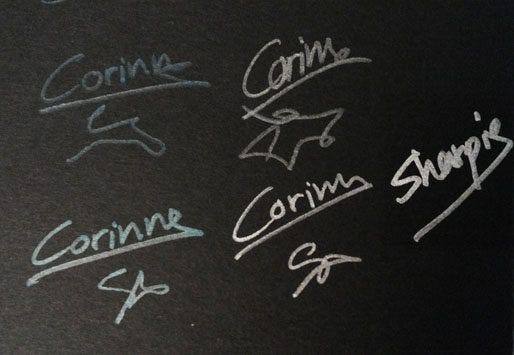
Finally, I wanted to take another look at those FC Pitt pens. I showed both versions of each color side-by-side here, as well as the Sharpie for comparison. While the duds were still markedly darker, the silver one is salvagable. I tested it out in one of my ARCs, and while not as lovely as the brighter version, it still holds up well:
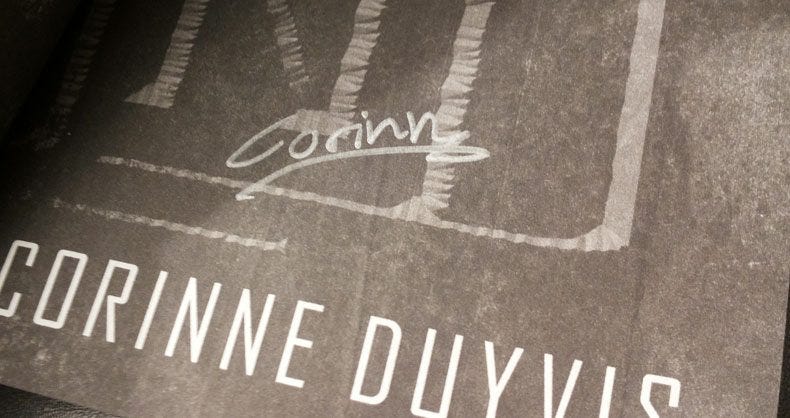
CONCLUSION
My personal choice is the silver Faber-Castell Pitt artist pen. Even the dud still works well. It writes smoothly, barely smudges, doesn't bleed, and is archival, to boot. (I'll also keep the blue version; it fits my cover, and that's impossible for me to resist. Unlike the silver dud, however, the blue dud's ink has such a tendency to disappear that I'll probably discard it.)
I gave serious thought to the Signo Broad, as a thinner line like that is easier to write with and it shows up wonderfully, but the incredible smudginess is hard to overcome.
Although I initially only included the Sharpie for comparison purposes, I'm keeping it around to sign my bookmarks with. It's the best and only choice. If it were acid-free, I'd also use it for my books, both because it shows up better than any of the other pens and so that I wouldn't have to lug two pens around; as it is, I feel safer sticking with archival pens for the actual books. I'll just have to deal with carrying multiple pens.
Of course, your priorities may vary, which is why I wanted to share these tests with other authors facing the simultaneous joy and difficulty of black title pages—that way people can decide for themselves.
If you have suggestions of your own for pens that work well on black paper, please share in the comments—I'd love to see what else is out there. I'm also happy to run additional tests with any of the above pens, if anyone has any questions.
[hr]
Corinne Duyvis, author of Otherbound, Amulet Books, June 2014
A lifelong Amsterdammer, CORINNE DUYVIS spends her days writing speculative MG and YA novels. She enjoys brutal martial arts and gets her geek on whenever possible. Her debut novel Otherbound, a YA fantasy, is out from Amulet Books on June 17, 2014.



